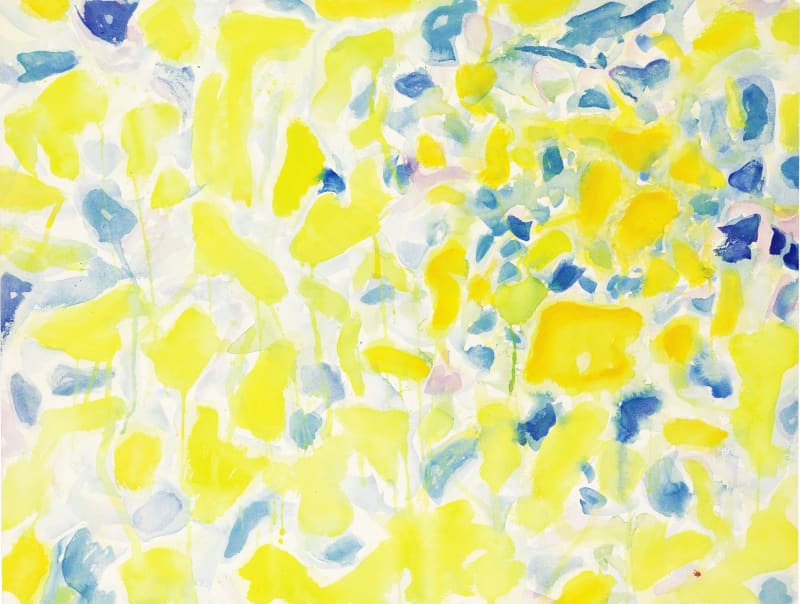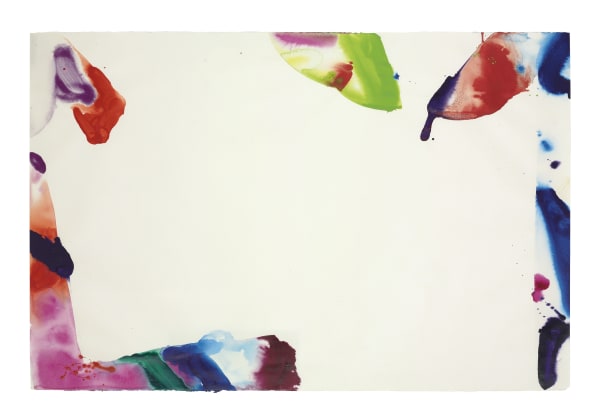Colour Is Light On Fire: Sam Francis Works on Paper
“Colour is light on fire. Each colour is the result of burning, for each substance burns with a particular colour.”
- Sam Francis
Omer Tiroche Gallery is pleased to announce our forthcoming exhibition Colour is Light on Fire: Sam Francis Works on Paper. The featured works span four pivotal decades of Francis’ career, from the early 1950s to the late 1980s, and will serve as a mini survey in celebration of the centennial of the artist’s birth. This exhibition aims to examine Francis’ pioneering and innovative exploration in the use of colour as well as highlight his critical contributions to both Tachisme and the Art Informel movement.
Born in San Mateo, California in 1923, Francis began his career as an aviation cadet in the US Army Air Corps Reserves, with hopes of becoming a reconnaissance pilot. After sustaining an injury whilst training, Francis was diagnosed with spinal tuberculosis and spent several years in a hospital bed. This experience proved pivotal for Francis. As a form of therapy, he began to paint, studying privately with artist David Park. With his initial dream dashed, he returned to Berkeley to study Art at the University of California.
Never one to conform, shortly after graduation Francis moved to Paris in 1950 at a time when his peers flocked to New York. It was during this transformative period that he was exposed to the work of Pierre Bonnard and Henri Matisse and became friends with the likes of Joan Mitchell, Jean-Paul Riopelle, and Michel Tapié. Soon, Francis’ distinctive bold splashes of colour brought him to the forefront of Taschisme and Lyrical Abstraction.
Whilst in Paris, Francis began a body of work that was inspired by an encounter with Monet’s Water Lilies at Musée de l'Orangerie. Later this series was regarded as one of the most significant in his fifty-year career. Monet’s influence can be keenly felt in the vividly radiant piece To Hölderlin (SF52-052), 1952, named after the German poet and philosopher Friedrich Hölderlin. Infused with the colour, space, and Provençal light of his new home, washes of lemon yellow and ultramarine dance and shimmer beyond the edges of the paper as if to suggest a much larger whole.
In 1957 Francis travelled to Japan. Whilst living and working in a Buddhist temple he observed the lessons of traditional Japanese haboku or flung-ink painting. As a result, his linework became more gestural and his articulation of space loosened. Echoing the Buddhist concept of ‘the void’, Francis acknowledged white as a colour. To him it represented the infinite of the universe and became an important feature of his compositions. Sketch (Ed Janss Series), 1963 illustrates Francis’ expansive use of white to create space and depth as well as accentuate colour in his work.
A true cosmopolitan, Francis found homes and studios across America, Europe, and Japan. The influence of these different cultures permeated into his work, resulting in his unique style of buoyant sweeping colours and lyrical compositions that are infused with both Western and Asian philosophies. Francis’ seminal practice has led him to become one the most important and celebrated artists of the 20th Century.
-
 Sam FrancisTo Hölderlin (SF52-051), 1952Watercolour on paper49.8 x 65 cm.
Sam FrancisTo Hölderlin (SF52-051), 1952Watercolour on paper49.8 x 65 cm.
19 ⅝ x 25 9/16 in.$ 250,000.00 -
 Sam FrancisUntitled (SF60-1140), 1960Acrylic on paper63.5 x 64.2 cm.
Sam FrancisUntitled (SF60-1140), 1960Acrylic on paper63.5 x 64.2 cm.
25 x 25 ¼ in.$ 110,000.00 -
 Sam FrancisUntitled (SF70-033), 1970Acrylic on paper69 x 104.2 cm.
Sam FrancisUntitled (SF70-033), 1970Acrylic on paper69 x 104.2 cm.
27 3/16 x 41 in.$ 75,000.00 -
 Sam FrancisUntitled (SF59-524), 1959Tempera on paper78.5 x 58 cm.
Sam FrancisUntitled (SF59-524), 1959Tempera on paper78.5 x 58 cm.
30 ⅞ x 22 13/16 in.$ 250,000.00
-
 Sam FrancisComposition (SF59-540), 1959Gouache and oil on card19.5 x 15 cm.
Sam FrancisComposition (SF59-540), 1959Gouache and oil on card19.5 x 15 cm.
7 11/16 x 5 ⅞ in.€ 70,000.00 -
 Sam FrancisSketch (Ed Janss Series), 1963Acrylic on paper57.2 x 76.2 cm.
Sam FrancisSketch (Ed Janss Series), 1963Acrylic on paper57.2 x 76.2 cm.
22 ½ x 30 in.€ 65,000.00 -
 Sam FrancisUntitled, 1972Acrylic on paper69 x 101.5 cm.
Sam FrancisUntitled, 1972Acrylic on paper69 x 101.5 cm.
27 3/16 x 39 15/16 in.$ 70,000.00 -
 Sam Francis, Untitled (SF74-413), 1974
Sam Francis, Untitled (SF74-413), 1974



















